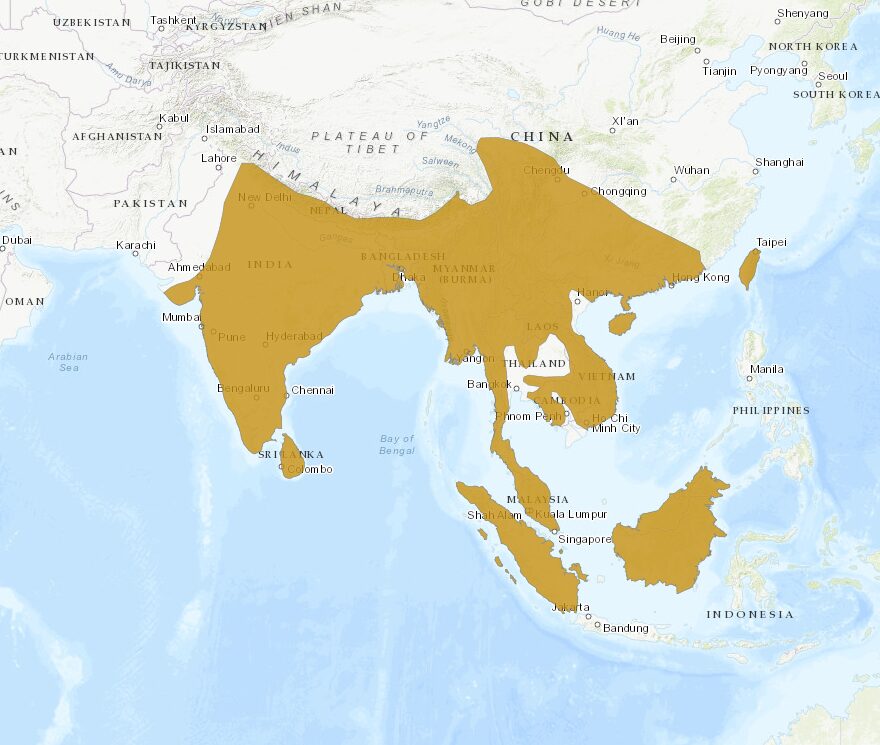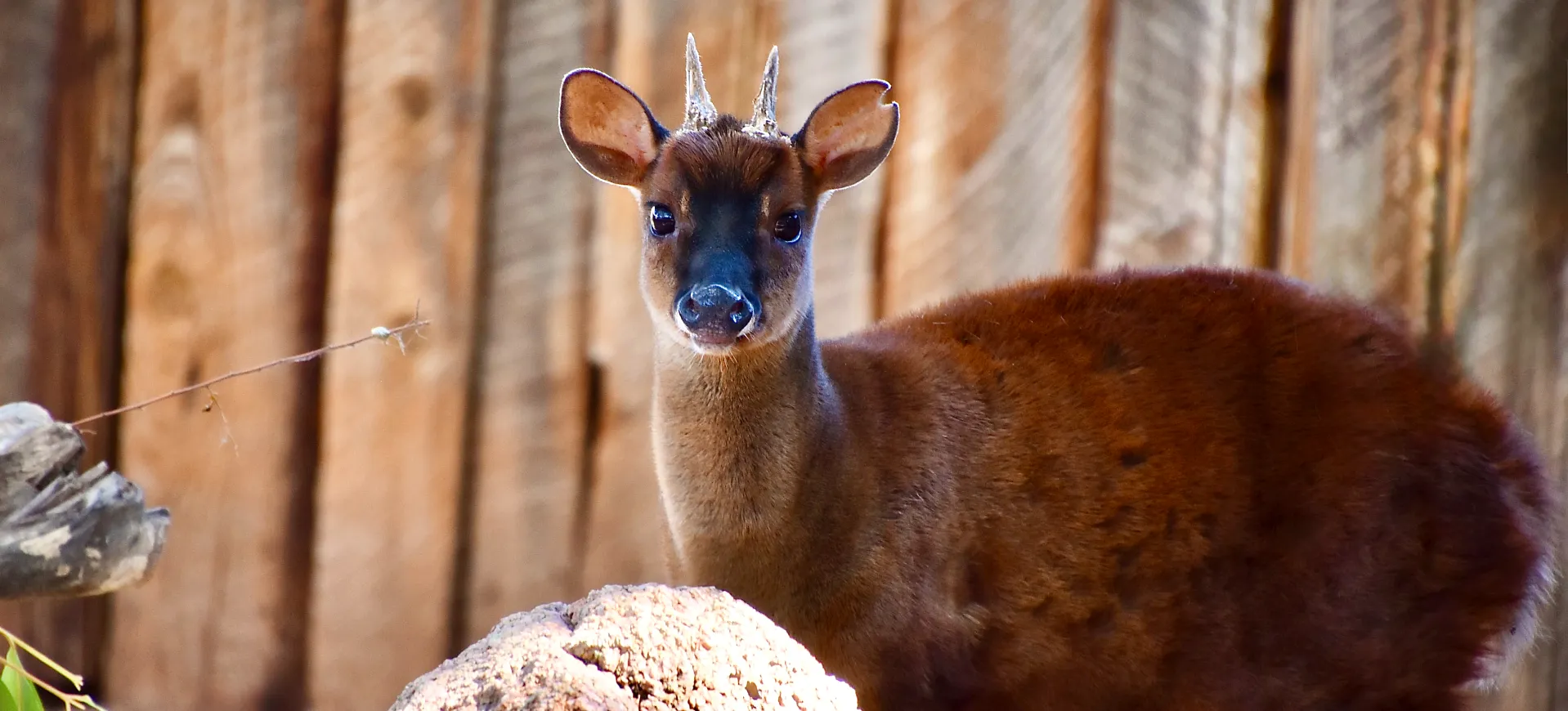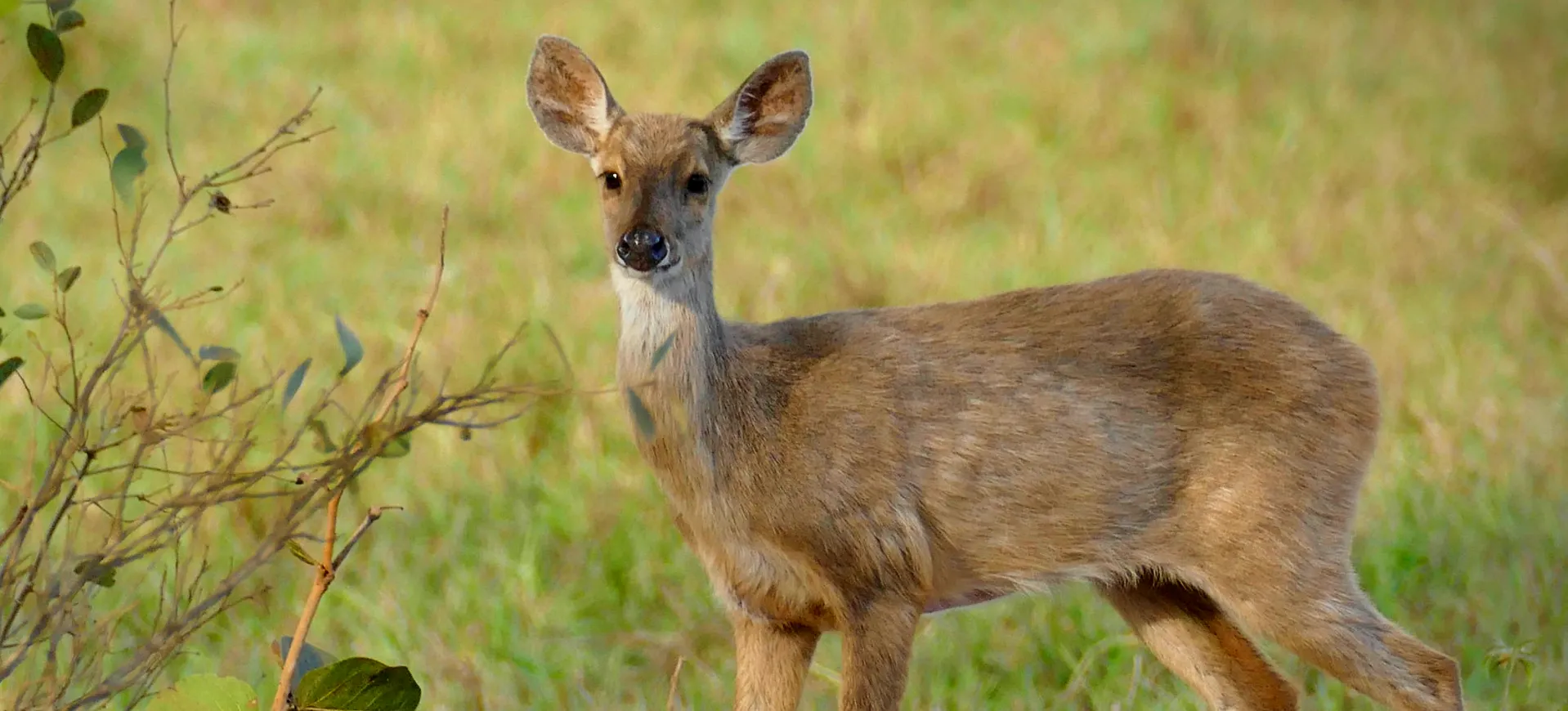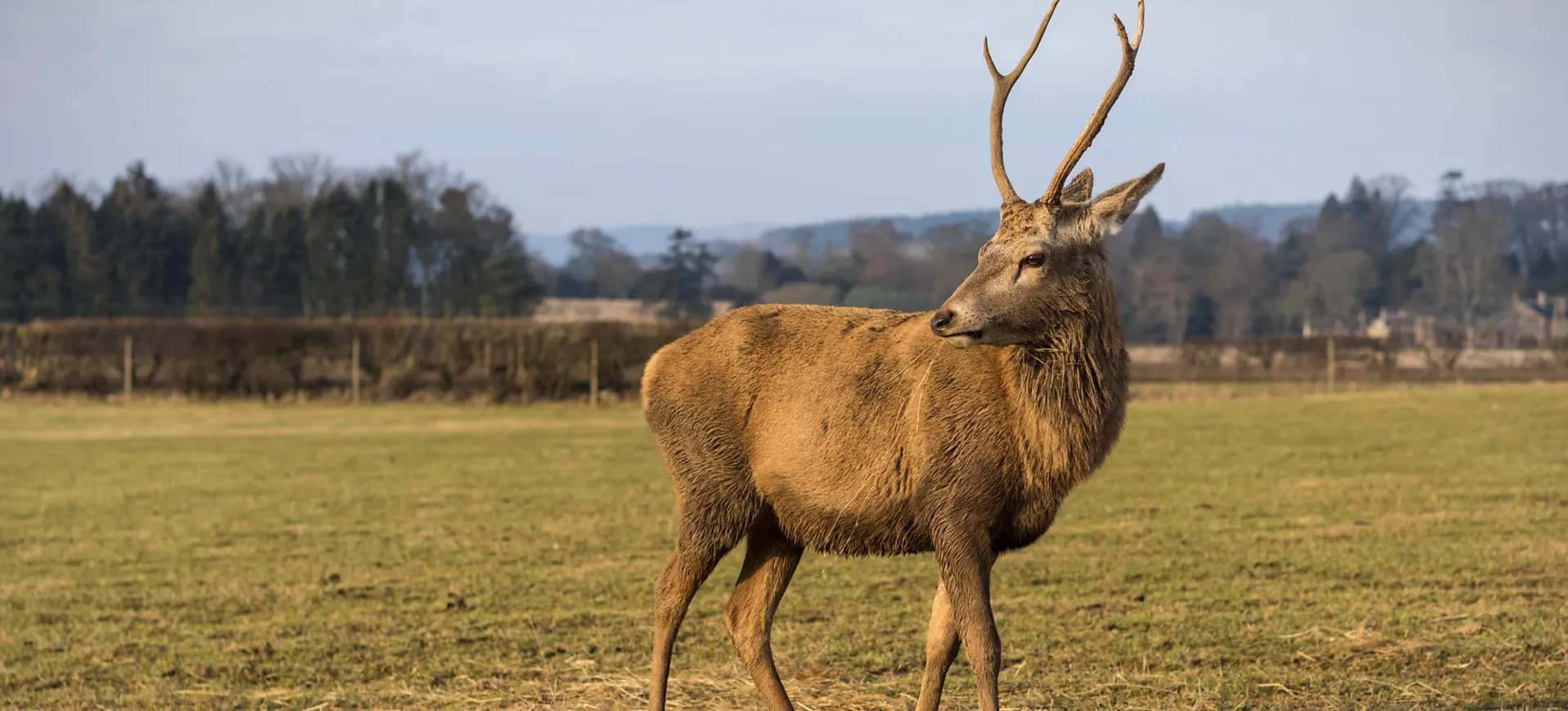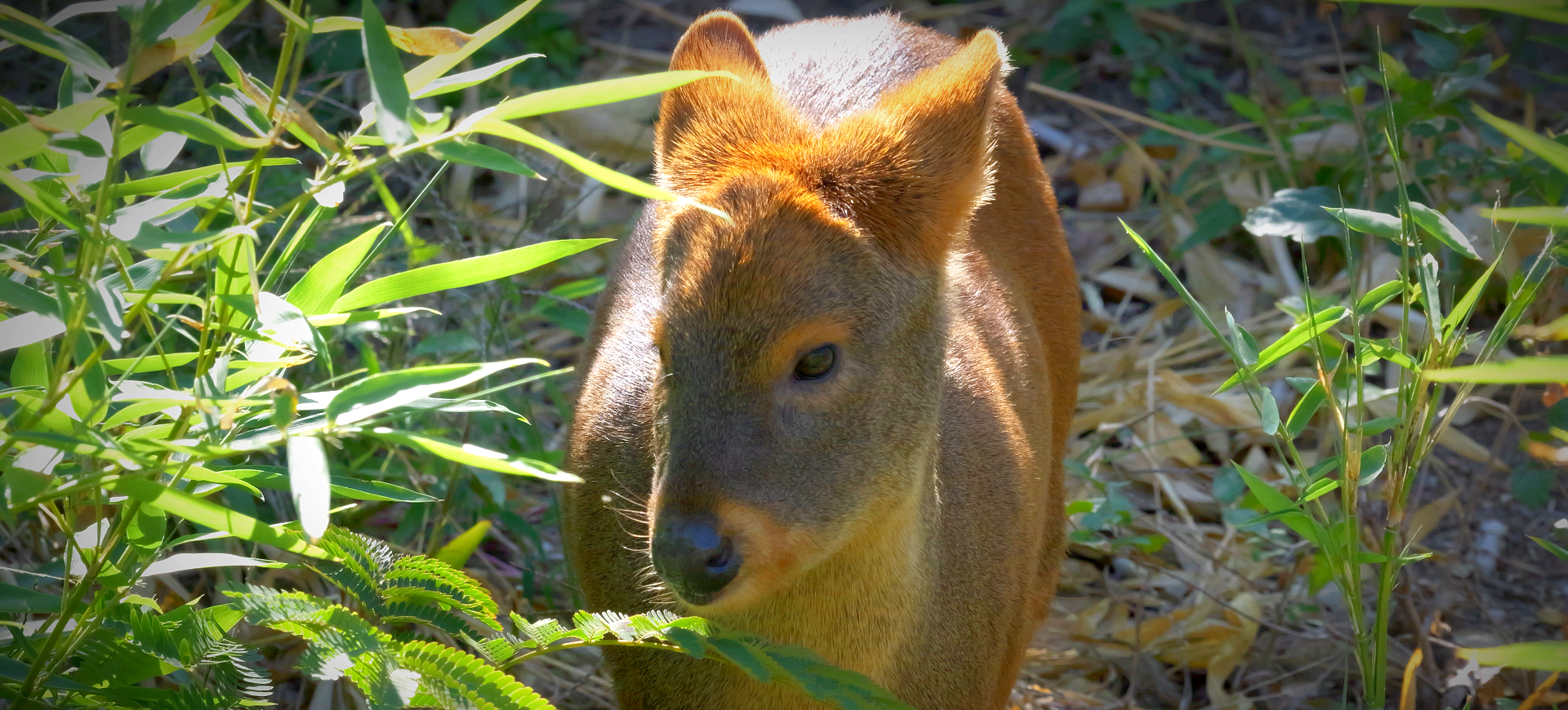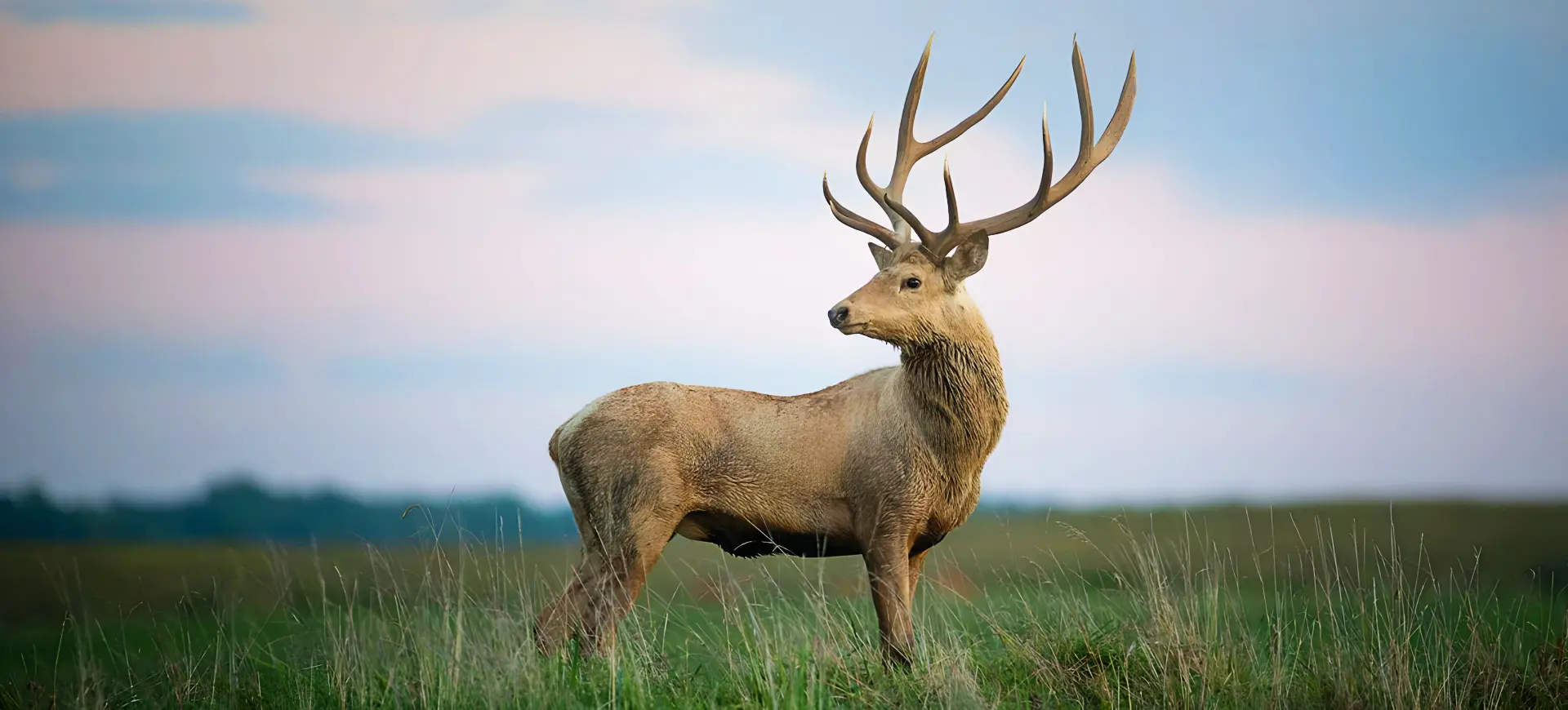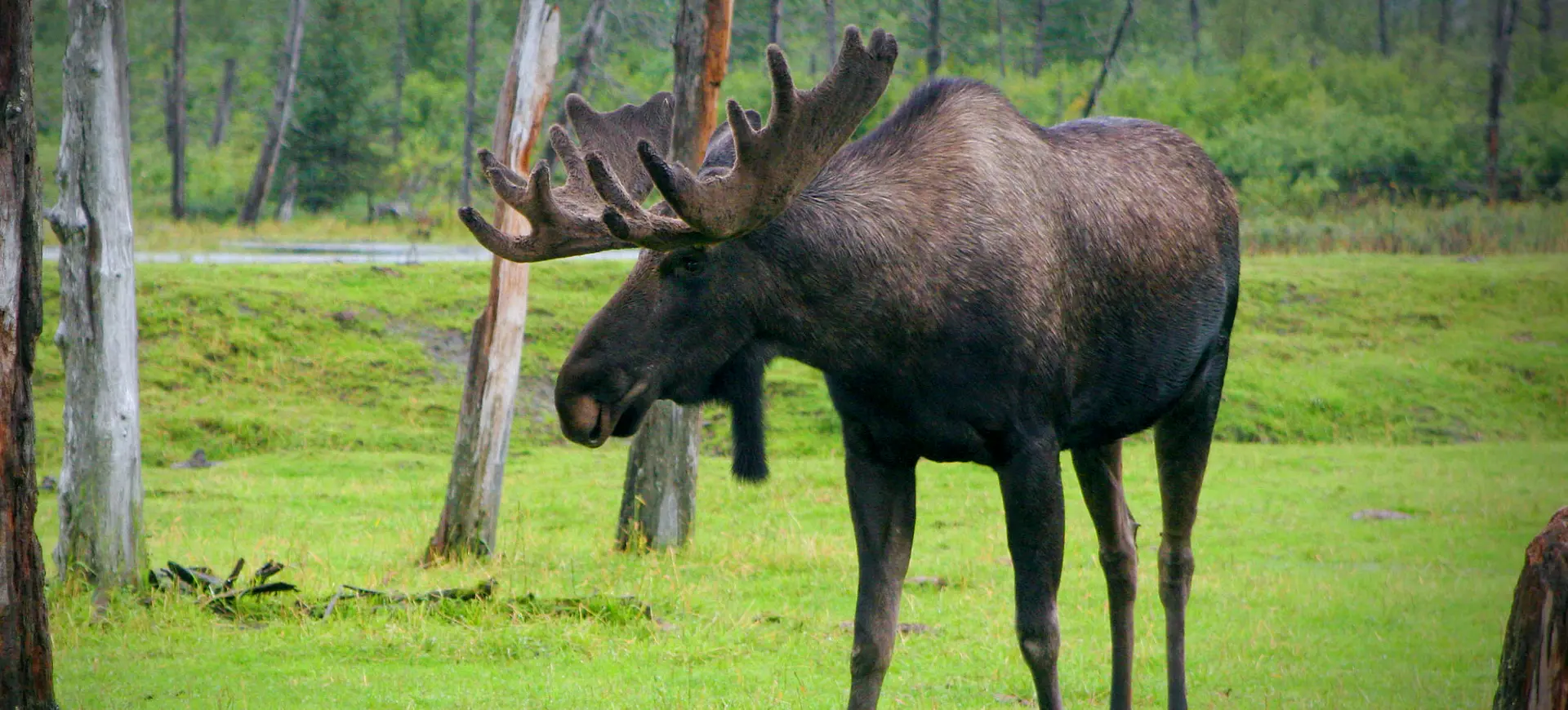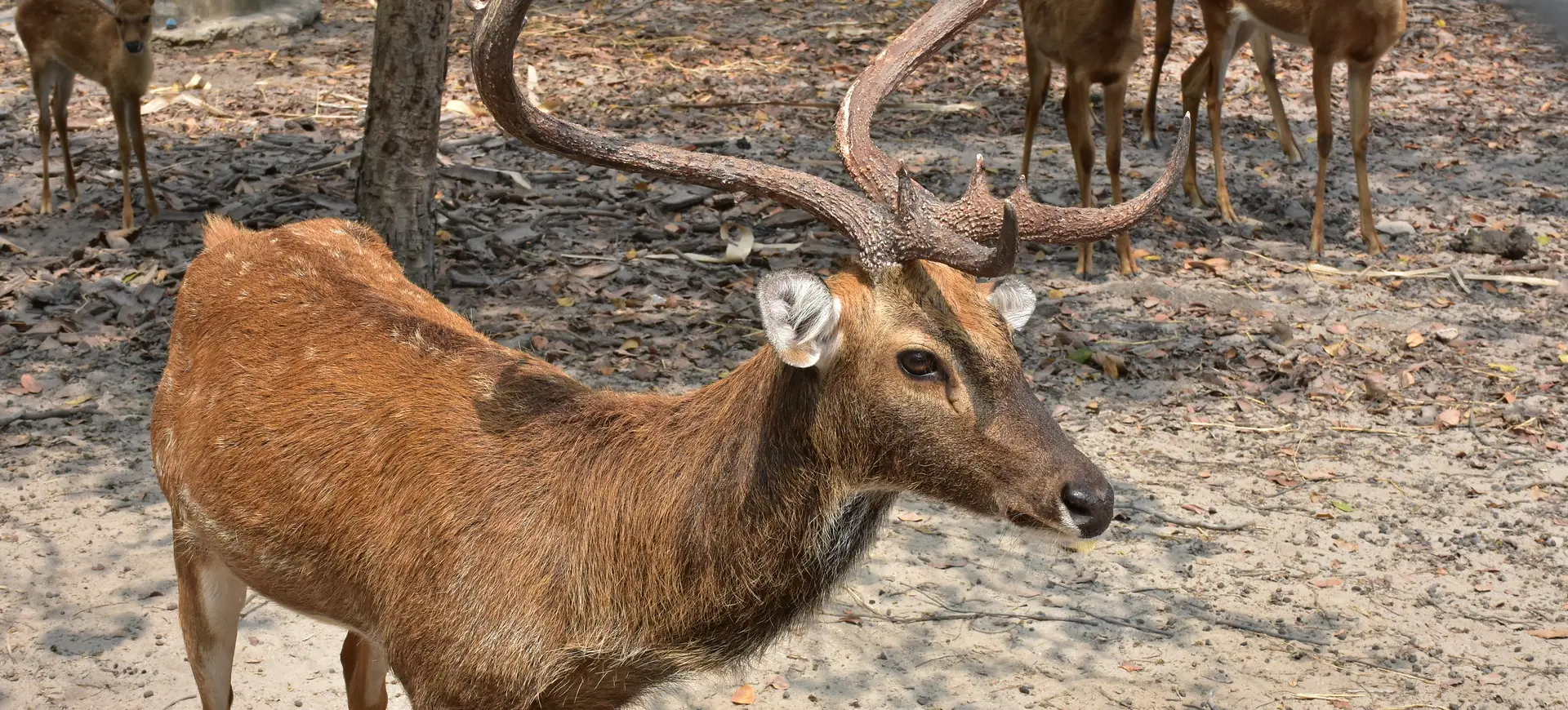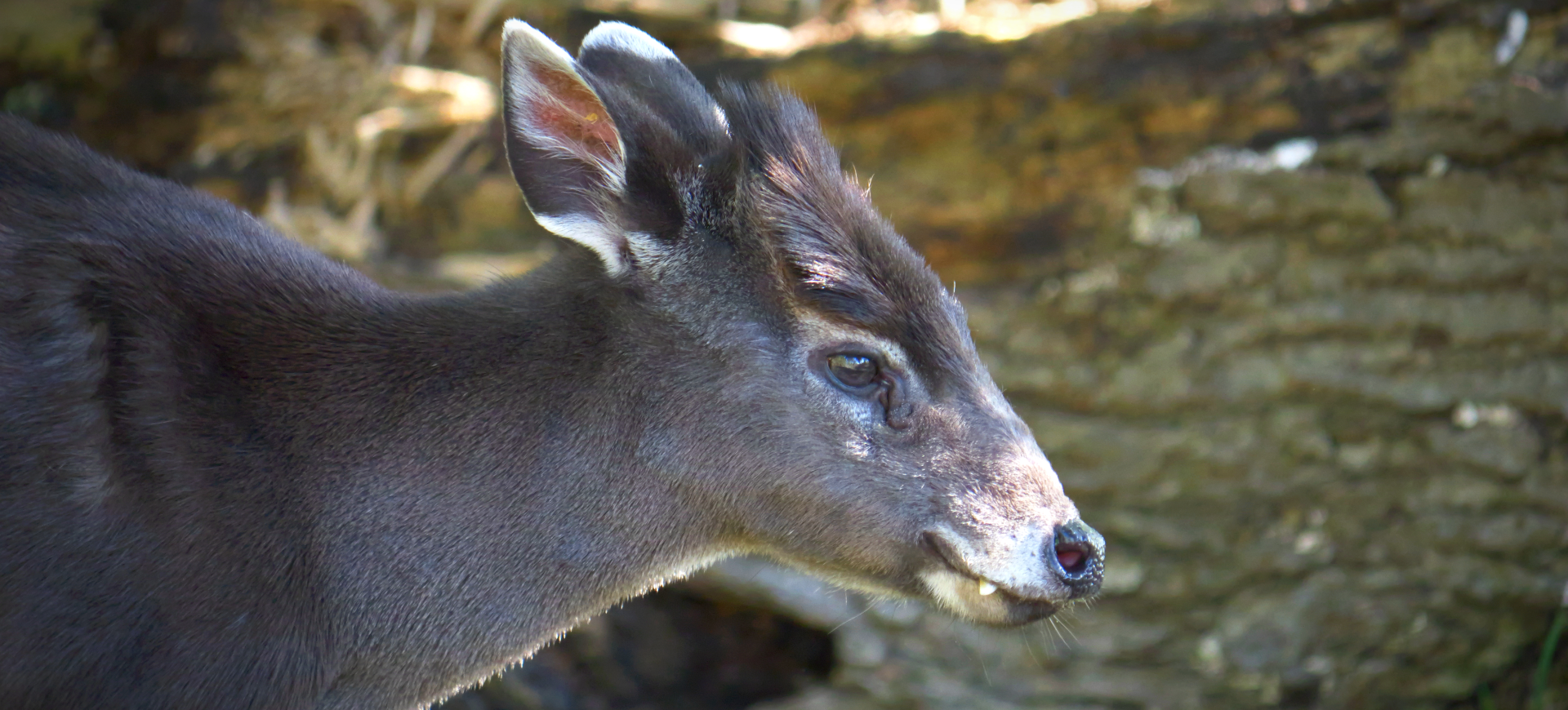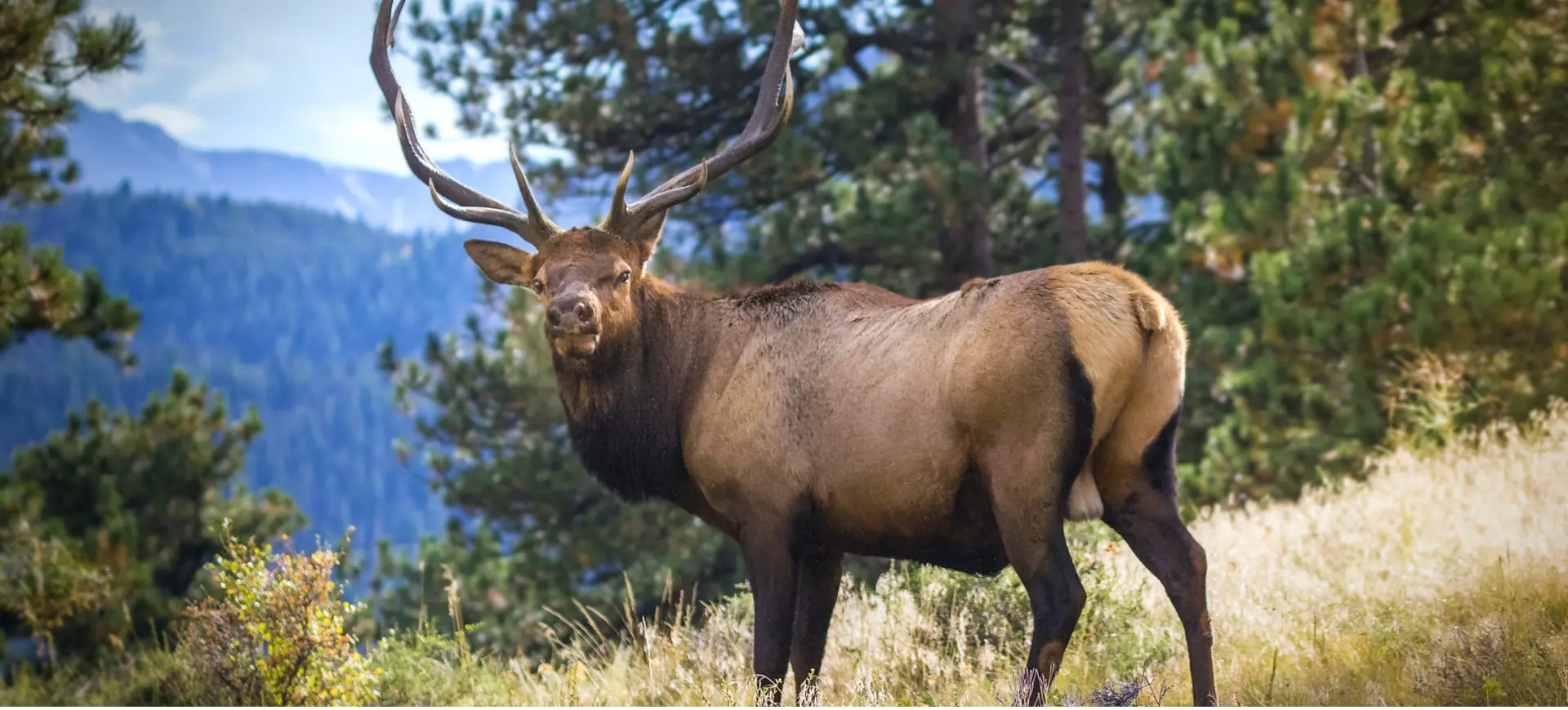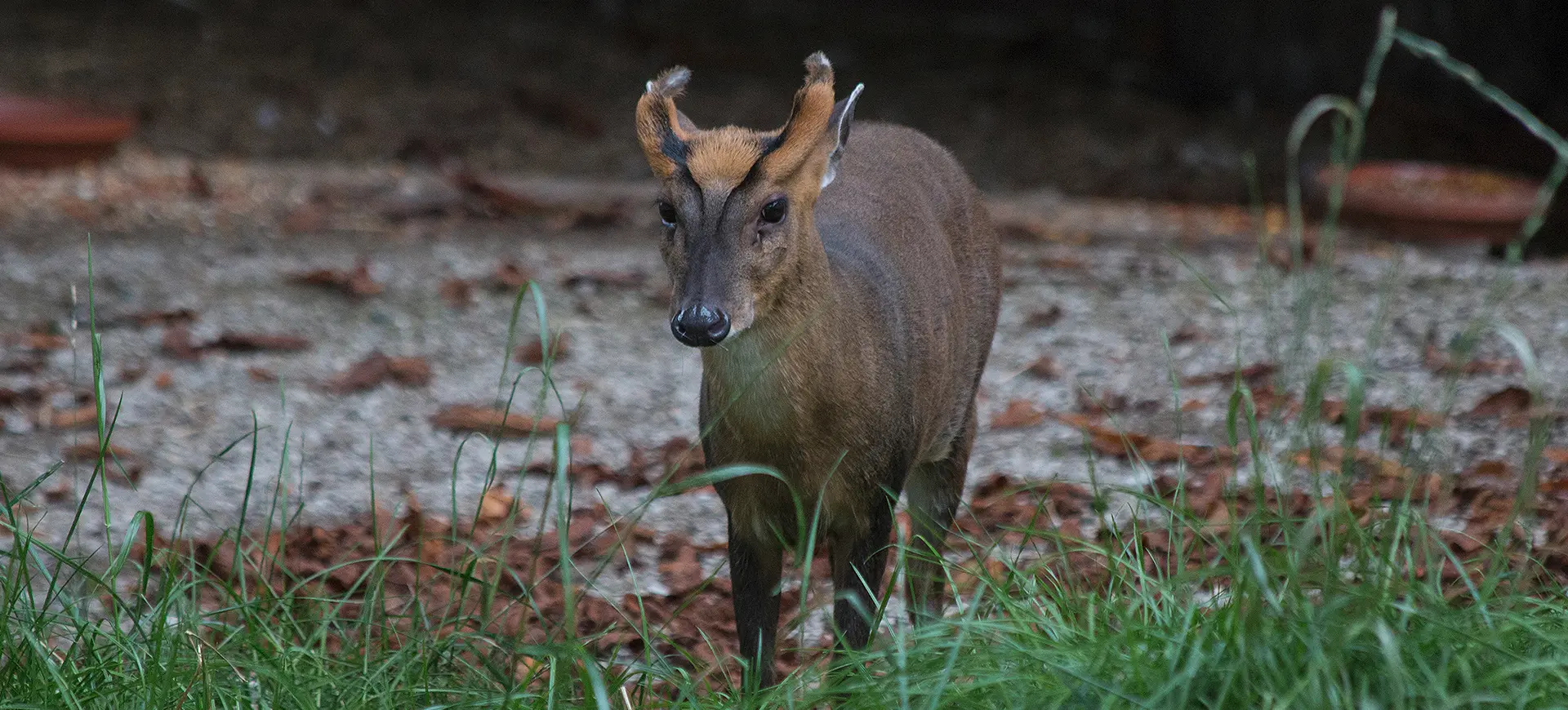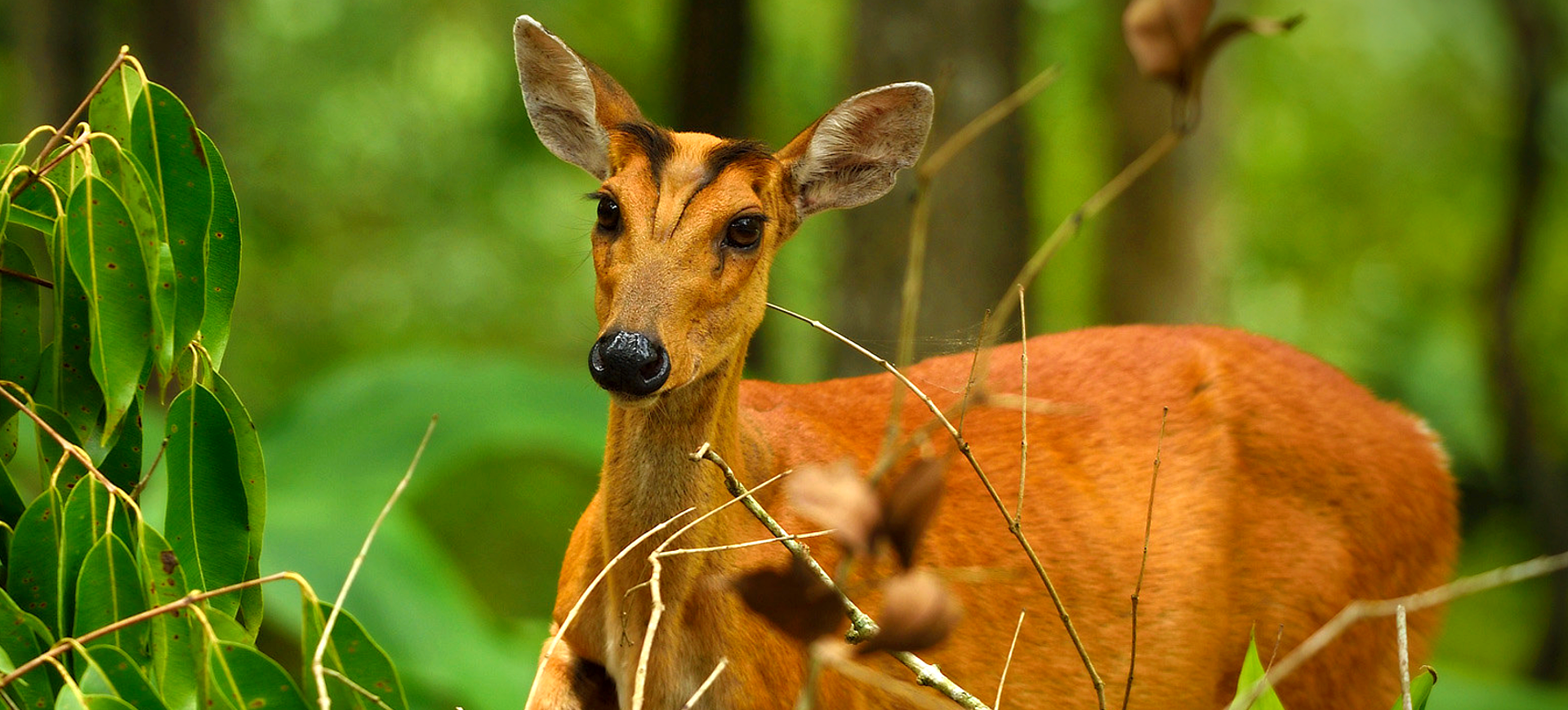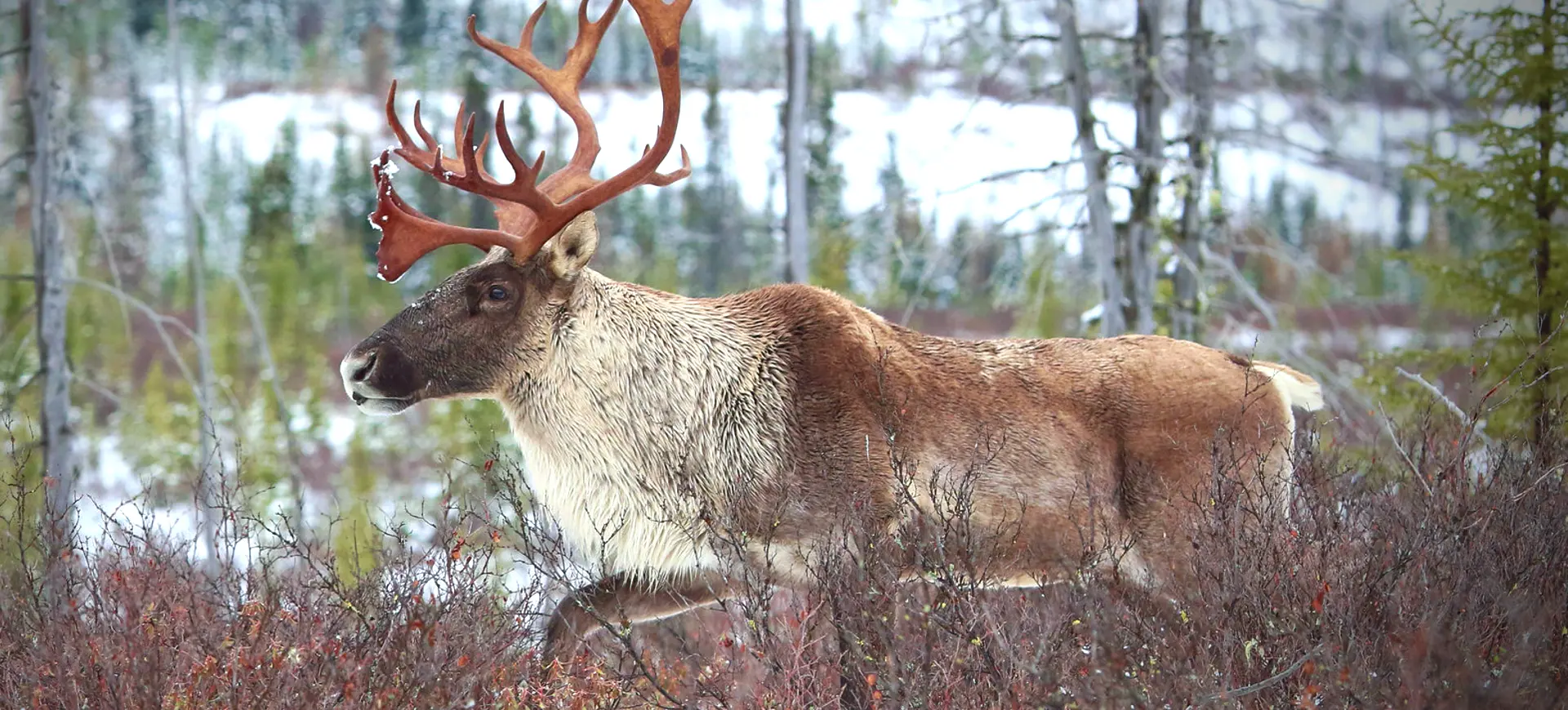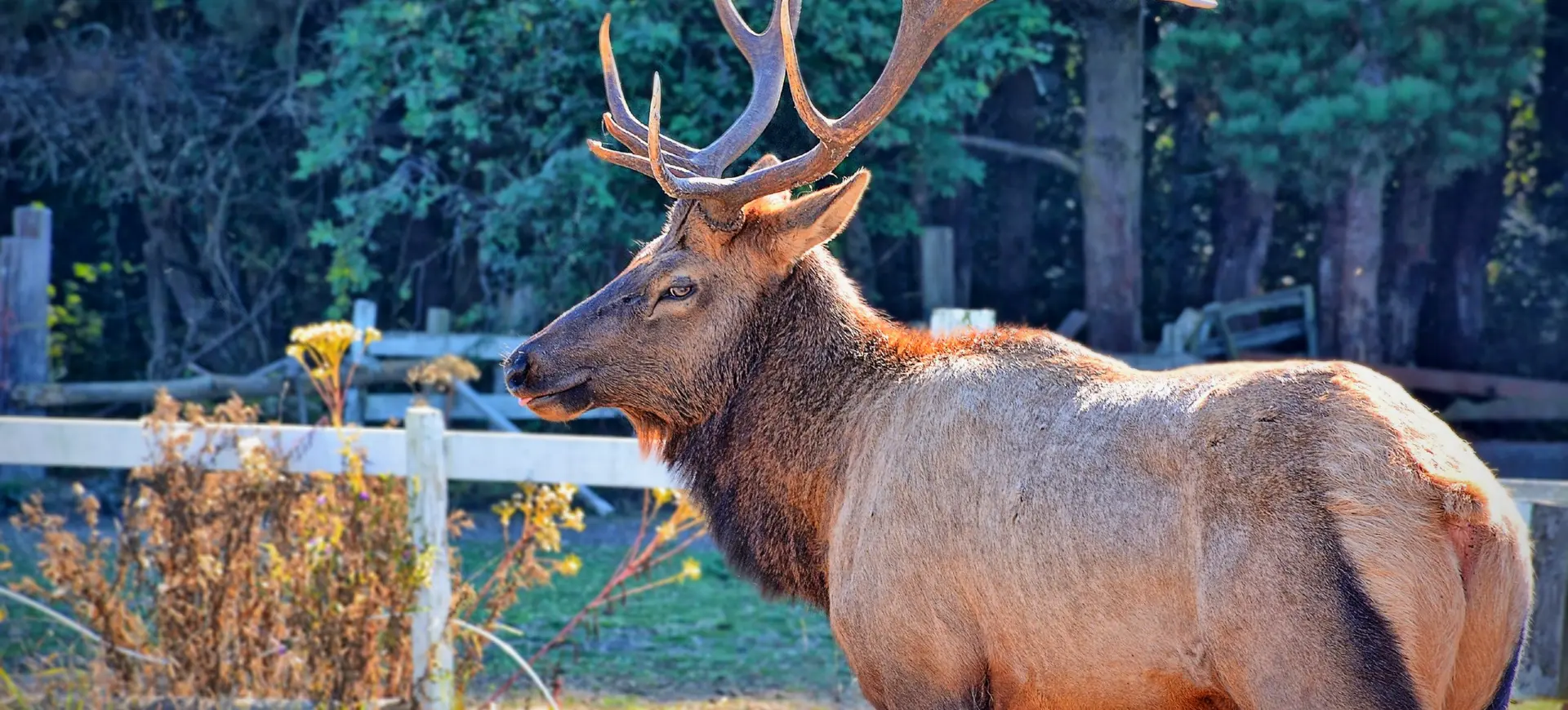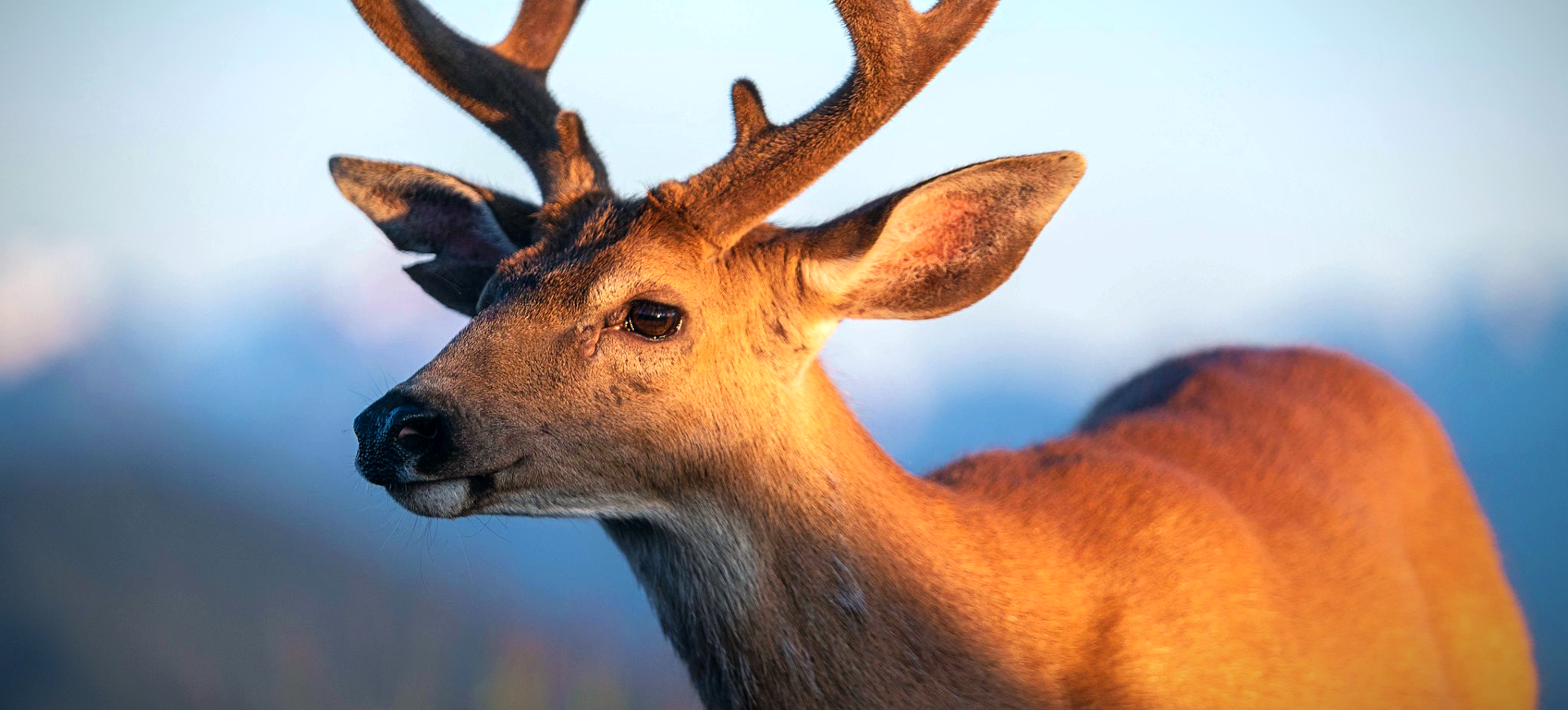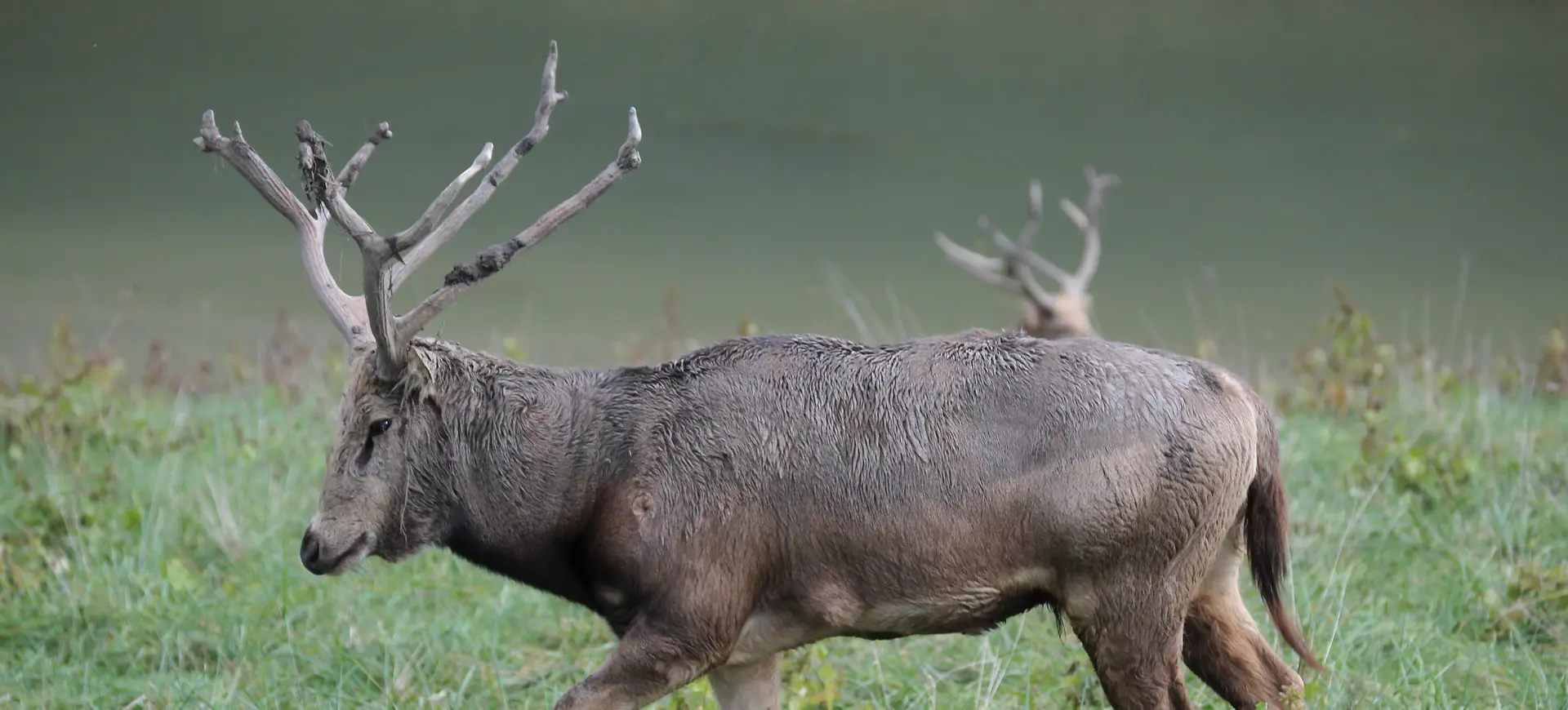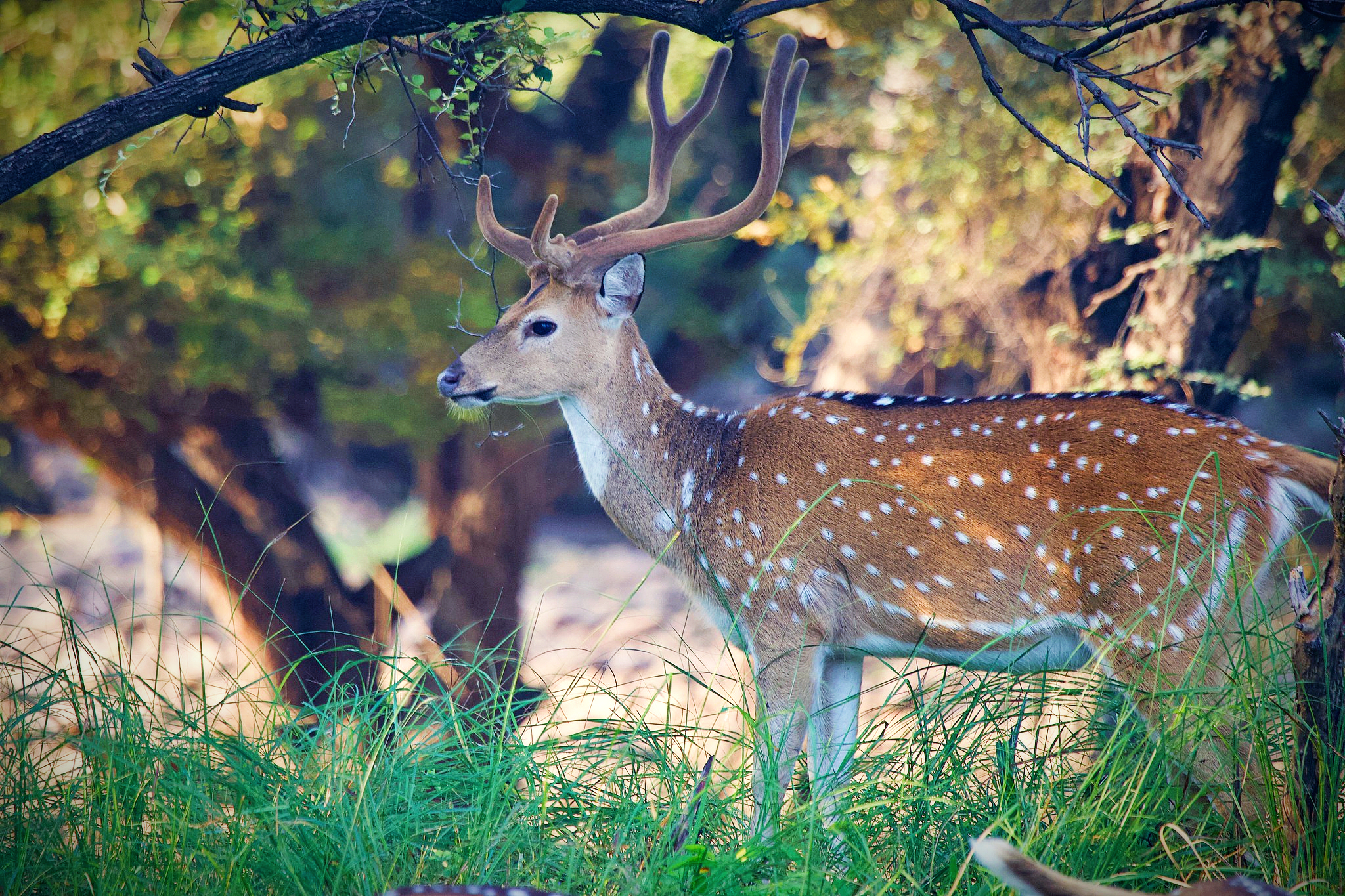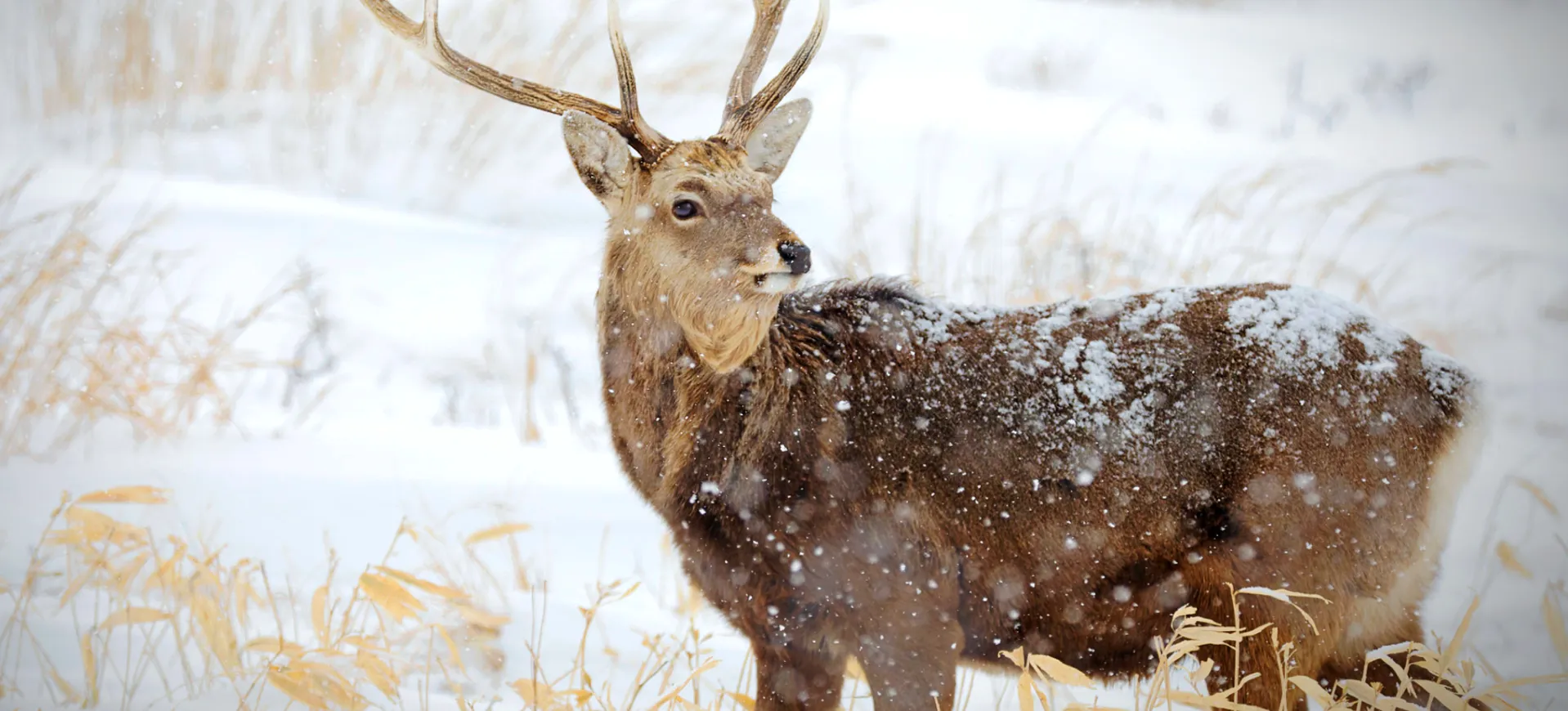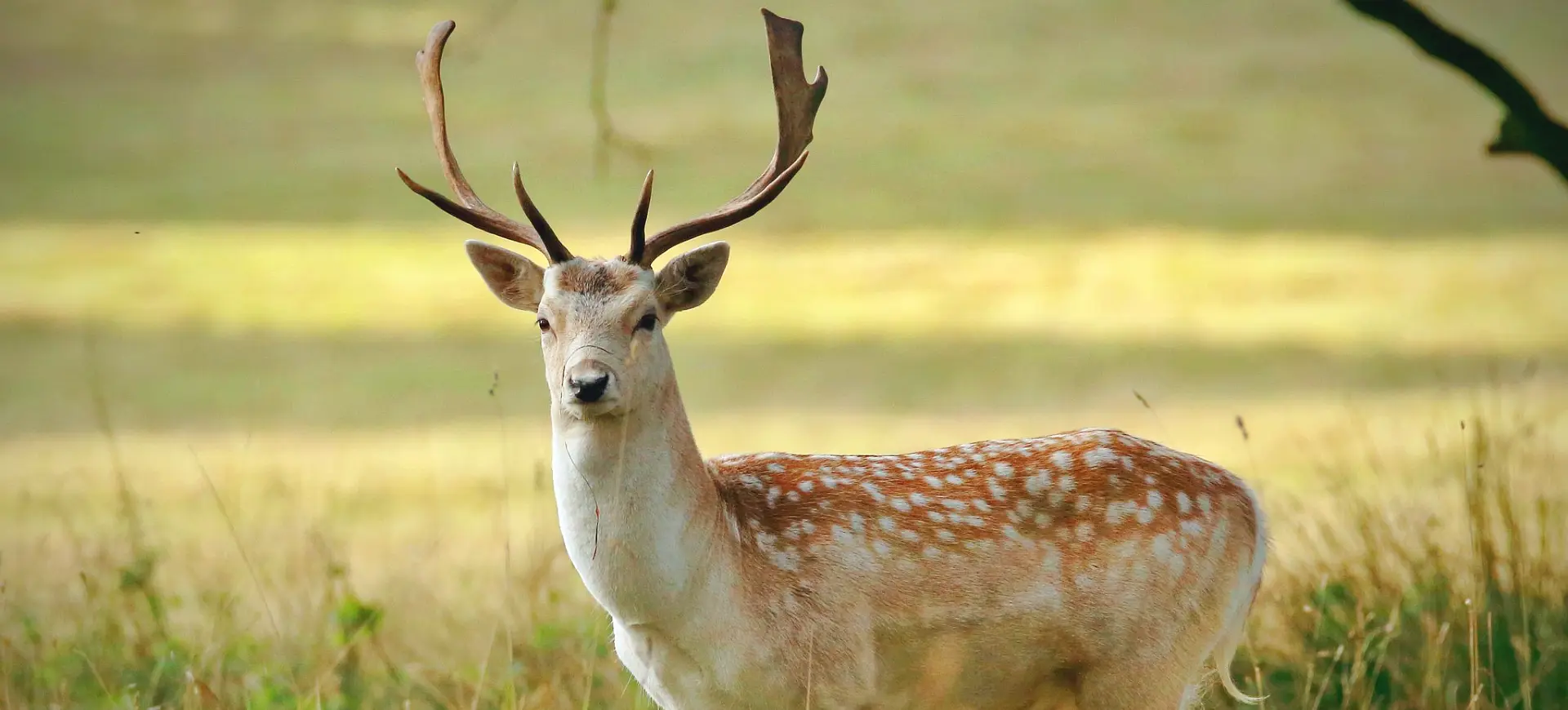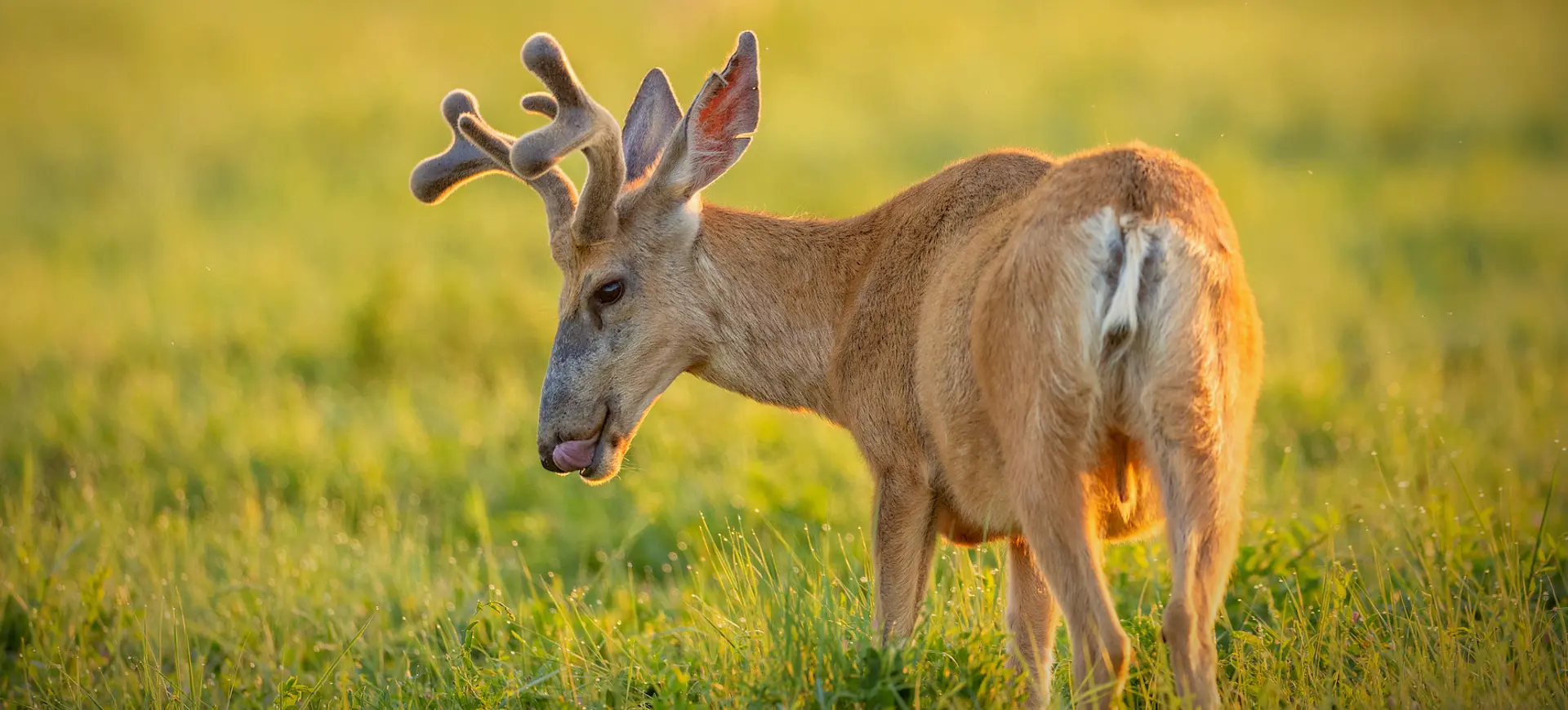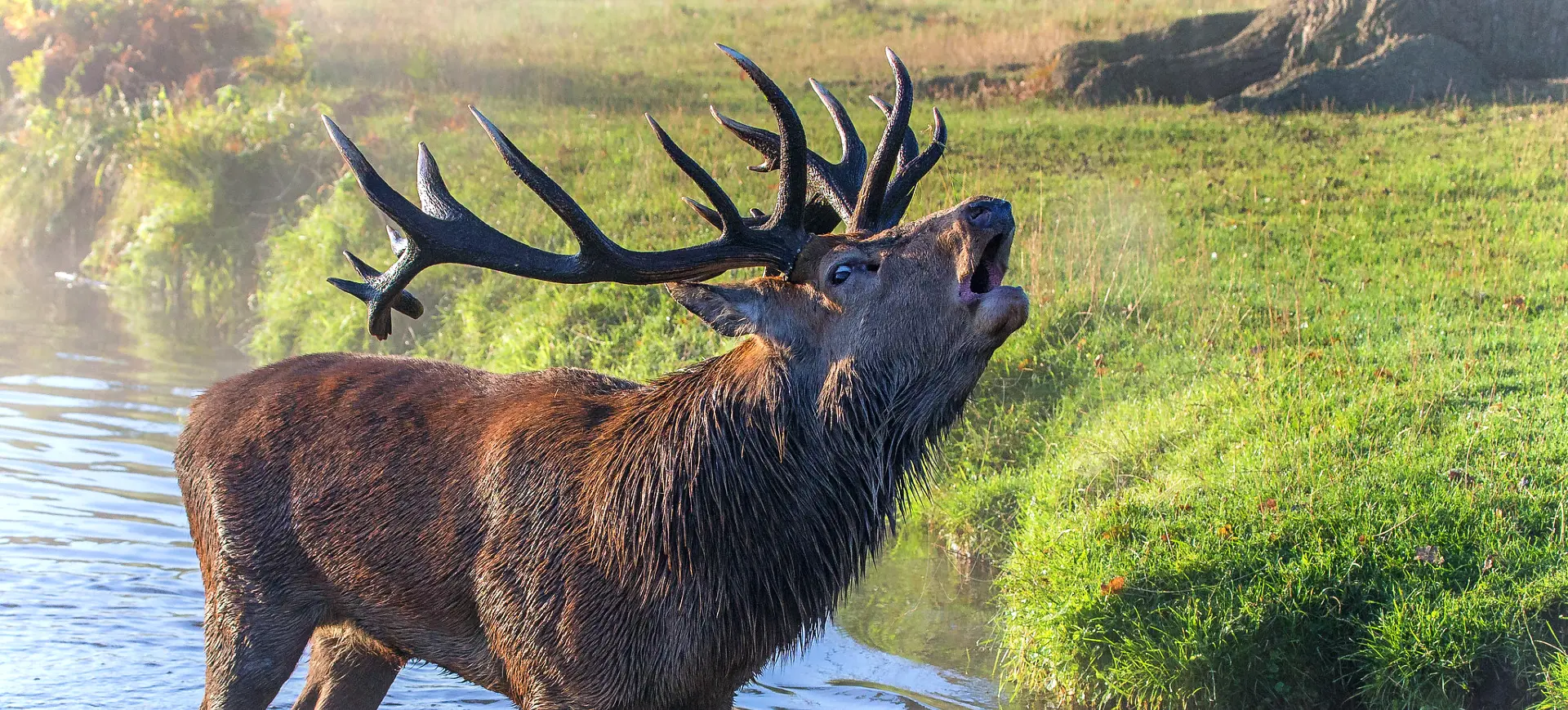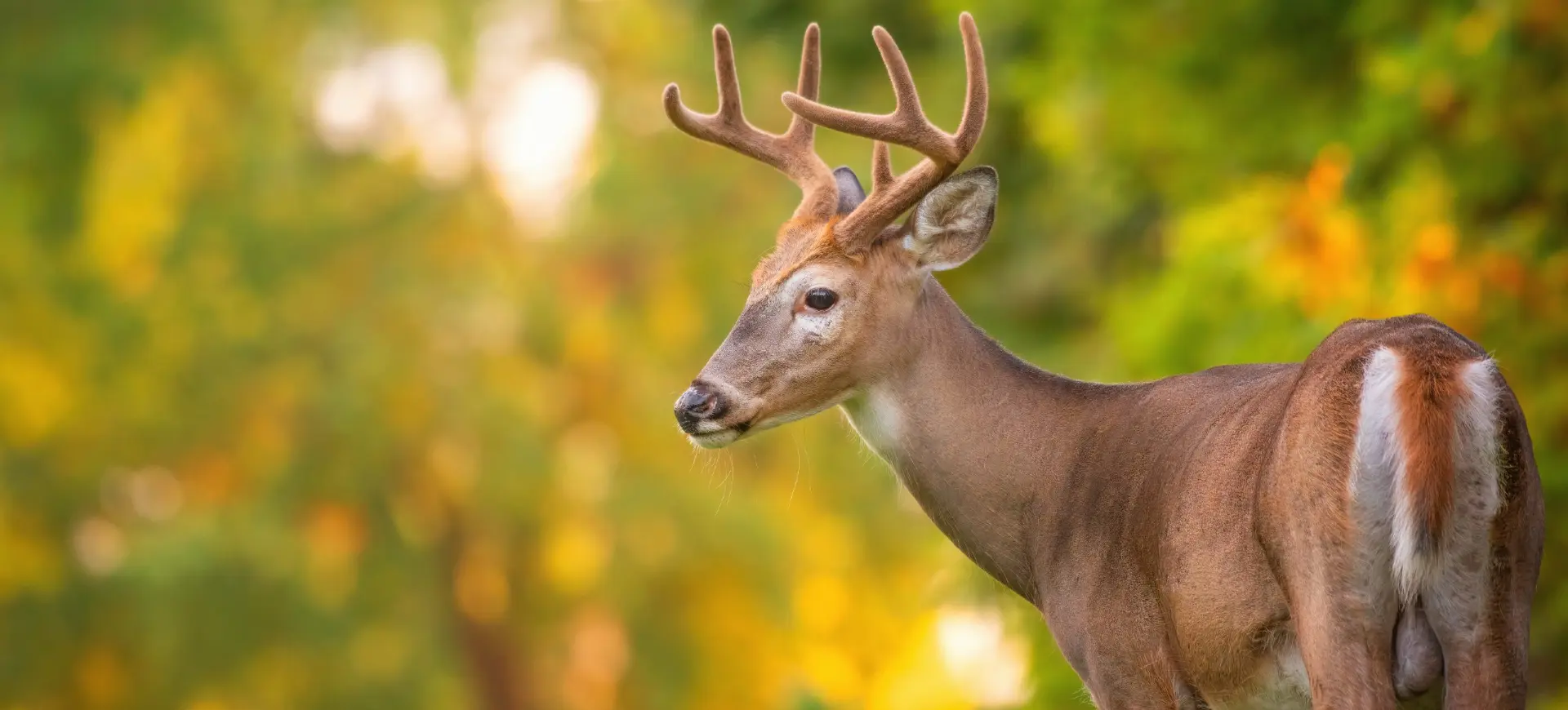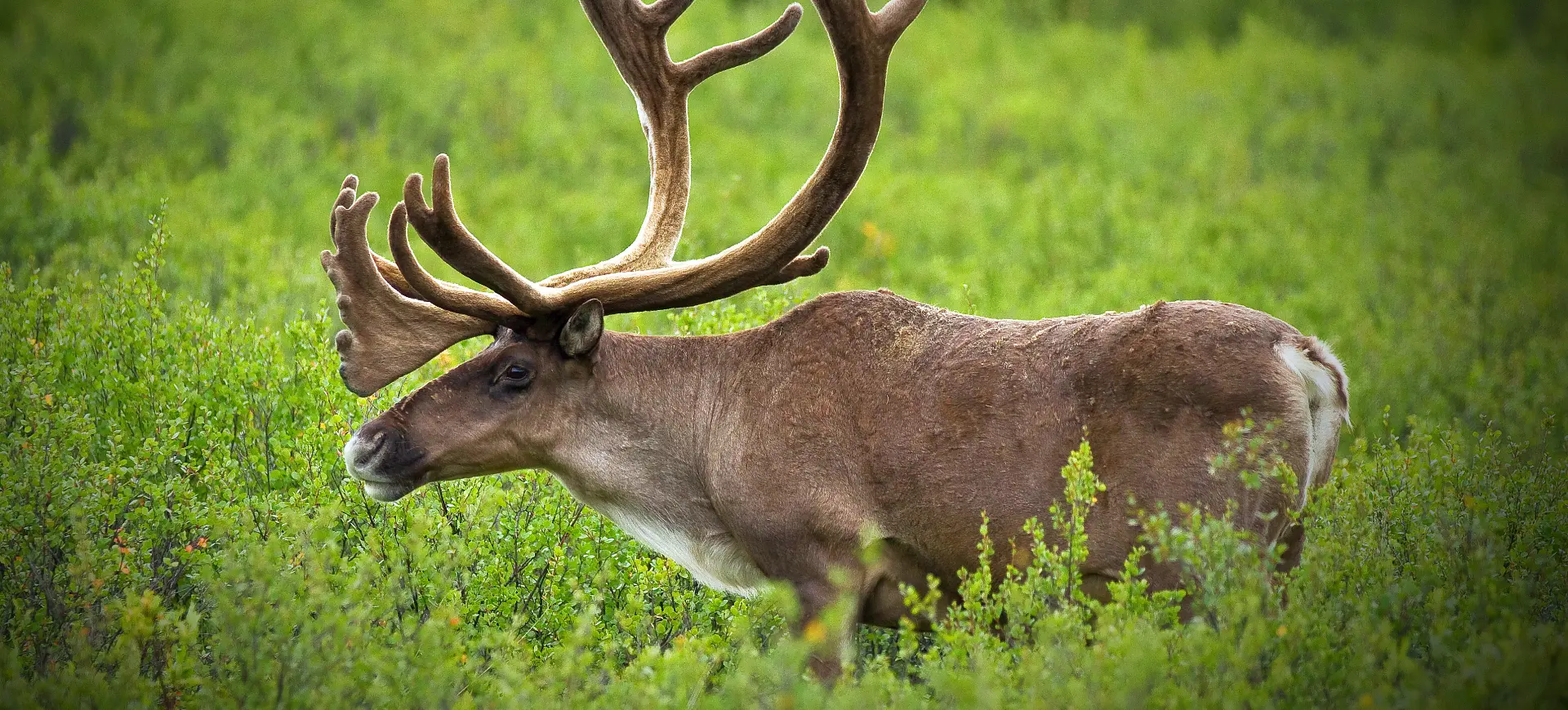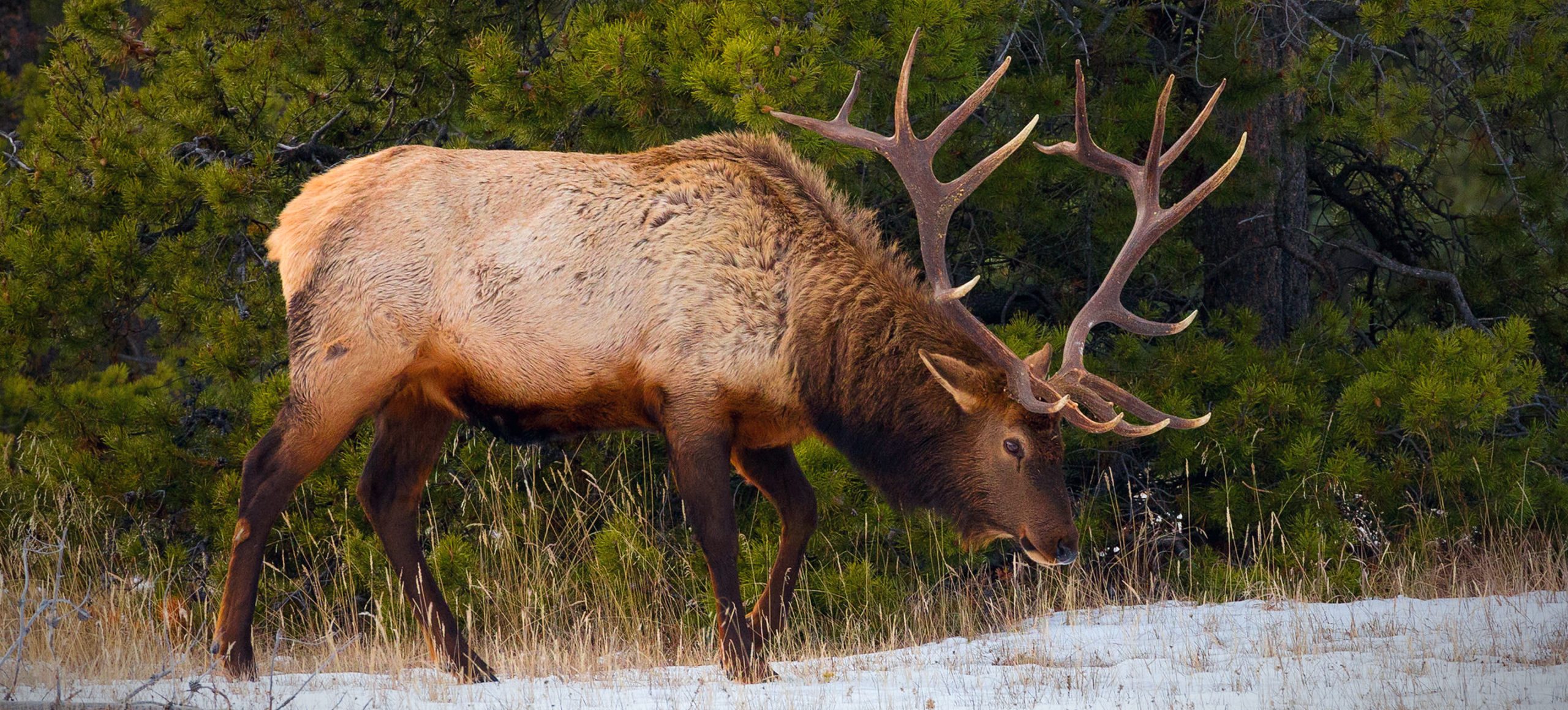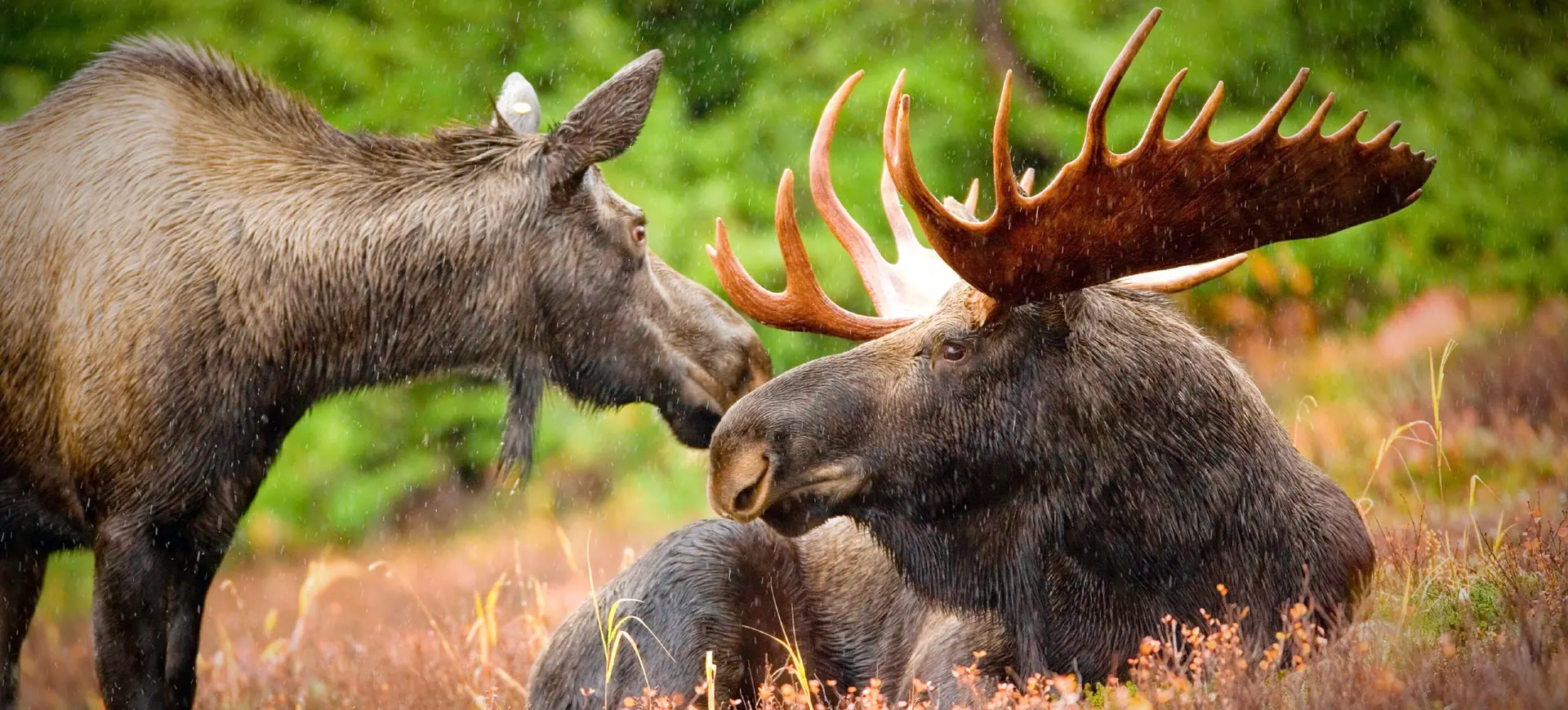Overview
The Sambar (Rusa unicolor) is a large deer species native to the Indian subcontinent, Southeast Asia, and Southern China. Recognizable by its robust build and large size, the Sambar is one of the largest deer species in the world. Adult males are particularly impressive with their rugged antlers, which can grow up to 110 centimeters in length. The coat color of Sambar varies from dark brown to grayish brown, providing camouflage in their forested habitats.
Sambar deer are highly adaptable and can thrive in various habitats, ranging from tropical dry forests to subtropical mixed forests. They are predominantly browsers, feeding on various vegetation, including leaves, fruit, and tender shoots. These deer are known for their ability to swim and often take to water to escape predators or to forage for aquatic plants. Sambar are most active during the twilight hours and at night, making them a primarily nocturnal species.
Socially, Sambar varies from being solitary to forming small groups, typically consisting of females with their young. Males are generally more solitary, especially outside the breeding season, known as the rut. During the rut, males become highly territorial and vocal, using loud calls to assert dominance and attract females. Sambar has been observed forming larger groups in areas with higher populations, especially around food-rich areas.
Taxonomy
Kingdom
Phylum
Class
Order
Family
Genus
Species
Sub Species
Type
Current distribution:
The Sambar's distribution in the wild is extensive, covering a large part of the Indian subcontinent, Southeast Asia, and Southern China. They are one of Asia's most widely distributed deer species, with populations varying in density across different regions. They are commonly found in protected areas such as national parks and wildlife sanctuaries in India. In Southeast Asia, their distribution is more fragmented due to habitat loss and hunting pressures.
Sambar populations have declined in some regions due to habitat destruction, poaching, and competition with domestic livestock. However, their populations remain stable and healthy in protected areas with effective conservation measures. Efforts to conserve their habitats and control hunting are crucial for maintaining their distribution in the wild. The Sambar's presence in diverse habitats highlights the importance of conserving various ecosystems to support their populations.
Physical Description:
Sambar deer have a heavy, compact body and relatively long legs. Adult males are significantly larger than females, with males standing up to 150 cm at the shoulder and weighing between 220-320 kg, while females are smaller, weighing up to 150 kg. Their coat is generally coarse and dense, providing effective insulation and protection. The antlers of male Sambar are a notable feature, typically having three points, and are shed annually.
The coloration of the Sambar’s coat varies geographically and seasonally, ranging from dark brown to grayish brown. Their underparts are generally lighter and have a distinctive ruff of hair around the neck. Juvenile Sambar have spotted coats, which they lose as they mature. Their large, expressive eyes and keen sense of hearing are vital for detecting predators in their dense forest habitats.

Lifespan: Wild: ~15 years || Captivity: ~20 years

Weight: Male: 485-705 lbs (220-320 kg) || Female: Up to 331 lbs (150 kg)

Length: Male: 6.6-8.5 feet (200-260 cm) || Female: 6-7.5 feet (180-230 cm)

Height: Male: 59-63 inches (150-160 cm) || Female: 55-59 inches (140-150 cm)

Top Speed: 35 mph (56 km/h)
Characteristic:
Native Habitat:
The Sambar is found in various habitats, from tropical rainforests to dry deciduous forests and savannah landscapes. They prefer dense vegetation cover for protection and are often found near water sources. Their native habitat includes the Indian subcontinent, Southeast Asia, and parts of Southern China. These regions adapt to various climatic conditions, from the humid tropics to the cooler mountainous regions.
Sambar deer are particularly well-suited to forested environments, where their coloration provides camouflage, and their agility allows them to navigate dense underbrush. They are also found in secondary forests and forest edges, adapting well to disturbed habitats. The presence of water bodies in their habitat is a significant factor for their distribution, as they rely on water not just for drinking but also as a refuge from predators and a source of food. Their adaptability to different environments has been a key factor in their widespread distribution and survival.
Biogeographical Realms:
Continents:
Diet:
Diet & Feeding Habits:
Sambar deer have a diverse diet, primarily consisting of vegetation such as leaves, grasses, fruit, and tender shoots. They are known to feed on over 130 different plant species, showcasing their adaptability in terms of diet. In addition to terrestrial plants, they feed on aquatic vegetation, often wading into water bodies to forage. Their feeding pattern is browsing and grazing, depending on the availability of food sources in their habitat.
Sambar has adapted to feeding on crops in certain regions, leading to conflicts with farmers. They have a four-chambered stomach, typical of ruminants, which allows efficient digestion of their fibrous diet. During dry seasons, Sambar may travel considerable distances for food and water, showcasing their resilience in changing environmental conditions. Their ability to adapt their diet and feeding behavior is key to their survival across diverse habitats.
Mating Behavior:
Mating Description:
The mating behavior of Sambar is characterized by the establishment of territories by males, who become more aggressive and vocal during the rutting season. The rutting season typically occurs in the late autumn and winter months. During this time, males mark their territory with scent marks and vocalize loudly to attract females and ward off rivals. Fights between males can be intense, involving using their large antlers in combat.
Females usually give birth to a single calf after a gestation period of about 8 months. The calves are well-developed at birth and can stand and walk quickly. Female Sambar are attentive mothers, often hiding their young in dense vegetation to protect them from predators. The social structure during the breeding season becomes more fluid, with males seeking to mate with multiple females and females occasionally moving between male territories.
Reproduction Season:
Birth Type:
Pregnancy Duration:
Female Name:
Male Name:
Baby Name:
Social Structure Description:
Sambar deer exhibit a flexible social structure, with group size and composition variations. Outside the breeding season, females and their young often form small groups, while adult males are more solitary or form small bachelor groups. During the breeding season, males establish territories and may gather a harem of females. The social dynamics of Sambar are influenced by factors such as habitat, food availability, and population density.
Sambar’s social behavior includes a range of vocalizations and scent markings used for communication and territory establishment. In areas with higher population densities, larger groups of Sambar may form, particularly around food sources or water bodies. The interaction between males during the rut is characterized by displays of dominance, including antler rattling and vocal calls. Understanding the social structure of Sambar is important for effective wildlife management and conservation strategies.
Groups:
Conservation Status:
Population Trend:
The Sambar population is currently classified as vulnerable, with a decreasing trend in the wild. This decline is primarily due to habitat loss, poaching, and competition with domestic livestock. In many parts of their range, especially in Southeast Asia, Sambar populations have been significantly impacted by illegal hunting for meat and antlers. Their populations are more stable in areas where conservation measures are effectively enforced, such as in certain national parks and wildlife sanctuaries in India.
The Sambar population’s challenges indicate broader issues affecting Asian wildlife, including habitat fragmentation and human-wildlife conflict. Conservation efforts are focused on habitat protection, anti-poaching measures, and mitigating conflicts with local communities. Research into their ecology and population dynamics is crucial for developing effective conservation strategies. The survival of the Sambar in the wild depends on continued and enhanced efforts to protect their natural habitats and control hunting pressures.
Population Threats:
The primary threats to the Sambar population include habitat loss due to deforestation, agricultural expansion, and urbanization. This habitat degradation leads to fragmentation and isolation of populations, impacting their genetic diversity and survival. Poaching for meat, antlers, and body parts used in traditional medicine is a significant threat, particularly in Southeast Asia. Competition with domestic livestock for grazing resources and water also challenges their survival in certain areas.
Human-wildlife conflict is another factor affecting the Sambar population, especially in regions where their habitat overlaps with agricultural lands. Crop raiding by Sambar can lead to retaliatory killings by farmers. Disease transmission from domestic livestock is an emerging concern, affecting the health of wild populations. Addressing these threats requires a multifaceted approach, including legal protection, community engagement, and habitat conservation.
Conservation Efforts:
The Sambar’s conservation efforts focus on habitat preservation and reducing hunting pressures. Protecting natural habitats and restoring degraded areas are critical for maintaining stable populations. Anti-poaching initiatives, stricter law enforcement, and awareness campaigns are essential to combat illegal hunting and trade. In areas where Sambar is known to conflict with human activities, community-based conservation programs are implemented to promote coexistence.
Research plays a significant role in conservation, providing insights into the Sambar’s ecology, behavior, and population dynamics. Conservation programs often involve collaboration between wildlife authorities, local communities, and international conservation organizations. Monitoring population trends and studying their movement patterns are important for developing targeted conservation strategies. Ensuring the long-term survival of the Sambar requires a holistic approach that addresses both ecological and socio-economic factors.
Additional Resources:
Fun Facts
- The Sambar deer is one of the largest deer species in the world, with males weighing up to 550 kg (1,210 lbs).
- Sambar deer are excellent swimmers and often enter water bodies to escape from predators or to consume aquatic plants.
- Their antlers can grow up to 110 cm (43 inches) in length, making them a prized trophy for hunters.
- Sambar deer have a unique vocal communication; males produce a deep, booming call that can be heard over long distances during the mating season.
- They play a crucial role in their ecosystem by acting as seed dispersers; their diet helps germinate and spread many forest plants.
- Sambar deer’s coat color varies significantly across their range, from dark brown to almost grey, aiding in camouflage in various habitats.
- Unlike many deer species, Sambar deer can be solitary or live in small groups, and large congregations are typically seen only in favorable feeding grounds.
- Their predators include tigers, leopards, and crocodiles, making Sambar deer an important part of the food web in their natural habitats.
- Sambar deer have a unique defense mechanism against predators; they stomp their feet and make a loud barking noise to alert other deer of danger.
- In some cultures, Sambar deer are considered sacred and are associated with hunting deities, reflecting their significance in local folklore and traditions.


